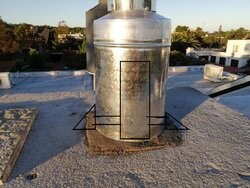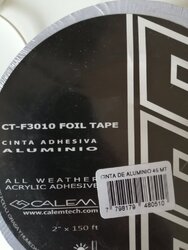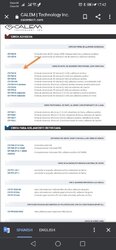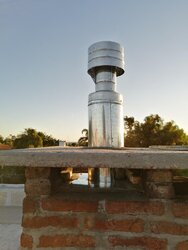Suggestions needed to feed a rigid tube liner above the roof with a flat concrete top.
- Thread starter yonny33
- Start date
-
Active since 1995, Hearth.com is THE place on the internet for free information and advice about wood stoves, pellet stoves and other energy saving equipment.
We strive to provide opinions, articles, discussions and history related to Hearth Products and in a more general sense, energy issues.
We promote the EFFICIENT, RESPONSIBLE, CLEAN and SAFE use of all fuels, whether renewable or fossil.
You are using an out of date browser. It may not display this or other websites correctly.
You should upgrade or use an alternative browser.
You should upgrade or use an alternative browser.
I am confused or rather got the guy in the local hardware store confused when I asked for steel pop rivets.
Apparently, they don't exist or you need a special rivet gun. I was not aware.
Got some stainless steel short screws with a flat head and some aluminium rivets possibly for the top parts of the liner that don't get so hot?
Surely the aluminium rivets will be ok for the pipes? What is the melting point of aluminium?
Screws for the lower parts maybe instead.
Could you clear up the procedure for steel rivets, please?
Thanks
Apparently, they don't exist or you need a special rivet gun. I was not aware.
Got some stainless steel short screws with a flat head and some aluminium rivets possibly for the top parts of the liner that don't get so hot?
Surely the aluminium rivets will be ok for the pipes? What is the melting point of aluminium?
Screws for the lower parts maybe instead.
Could you clear up the procedure for steel rivets, please?
Thanks
Last edited:
gthomas785
Minister of Fire
I don't know what to tell you. Stainless steel blind rivets aren't too hard to find around here.
You can install them with a hand riveting tool. It takes a bit more force than the aluminum ones but I've done it. Professionals would probably use a powered rivet gun.
Aluminum melts at 660 C. That is slightly higher than the recommended flue operating temperatures, but can be easily reached momentarily during startup or if you forget to close down the stove, or if you have a chimney fire. It might be okay, but I can not recommend using aluminum components anywhere in your flue path.
You can install them with a hand riveting tool. It takes a bit more force than the aluminum ones but I've done it. Professionals would probably use a powered rivet gun.
Aluminum melts at 660 C. That is slightly higher than the recommended flue operating temperatures, but can be easily reached momentarily during startup or if you forget to close down the stove, or if you have a chimney fire. It might be okay, but I can not recommend using aluminum components anywhere in your flue path.
Thanks. I'll use screws for the lower sections near the stove.I don't know what to tell you. Stainless steel blind rivets aren't too hard to find around here.
You can install them with a hand riveting tool. It takes a bit more force than the aluminum ones but I've done it. Professionals would probably use a powered rivet gun.
Aluminum melts at 660 C. That is slightly higher than the recommended flue operating temperatures, but can be easily reached momentarily during startup or if you forget to close down the stove, or if you have a chimney fire. It might be okay, but I can not recommend using aluminum components anywhere in your flue path.
This ceramic fibre stuff is fragile
I've taped one up with the aluminum tape. Should be fine. Got it some fine galvanised wire also that I'll wrap around.
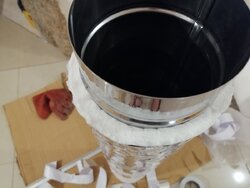
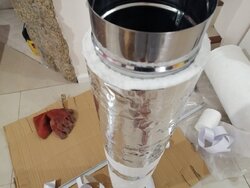
Yep I see the steel pop rivets are widely available in the UK.
Here non-existent and they have no knowledge of them in my local hardware stores or online.
The reality of living in a tiny developing country with traditional methods still ripe. They keep cars going as long as possible, reboring engines, grinding crankshafts, making carb jets themselves etc. Many small workshops like these. Nice to see though. Less wasteful.
The plan is to use the aluminum ones on most sections but with also a backup steel screw in case of failures.
Here non-existent and they have no knowledge of them in my local hardware stores or online.
The reality of living in a tiny developing country with traditional methods still ripe. They keep cars going as long as possible, reboring engines, grinding crankshafts, making carb jets themselves etc. Many small workshops like these. Nice to see though. Less wasteful.
The plan is to use the aluminum ones on most sections but with also a backup steel screw in case of failures.
gthomas785
Minister of Fire
In that case I think short steel screws would be fine to hold the sections together.Yep I see the steel pop rivets are widely available in the UK.
Here non-existent and they have no knowledge of them in my local hardware stores or online.
The reality of living in a tiny developing country with traditional methods still ripe. They keep cars going as long as possible, reboring engines, grinding crankshafts, making carb jets themselves etc. Many small workshops like these. Nice to see though. Less wasteful.
The plan is to use the aluminum ones on most sections but with also a backup steel screw in case of failures.
gthomas785
Minister of Fire
hmm one big concern now is the glue on the aluminum tape is quite flammable. I lit a match on a bit of tape and it caught fire for a second then went out once all the glue had burnt off
What to do now?
Even though the tape won't be in contact with a direct flame and it is on the outside of the ceramic fiber should I rethink how to wrap the fiber?
Burning match – For such a small flame, a household match burns at around 600-800°C
There are not other combustibles in the flue at all. Just brick and mortar.
maybe a test in the oven with some of the tape?

What to do now?

Even though the tape won't be in contact with a direct flame and it is on the outside of the ceramic fiber should I rethink how to wrap the fiber?
Burning match – For such a small flame, a household match burns at around 600-800°C
There are not other combustibles in the flue at all. Just brick and mortar.
maybe a test in the oven with some of the tape?
Last edited:
gthomas785
Minister of Fire
Okay this is getting a little outside of my knowledge area. Maybe someone else will offer their opinion. I believe, at least with the UL listed chimney liners, the insulation blanket allows for zero clearance to combustible material like that tape adhesive. But I could be wrong.
In reality I don't think it will be a problem as long as it's on the outside of the insulation.
If you'd rather, you could try tying some lightweight chicken wire/hardware cloth around it instead of using the tape. I have a feeling that would be difficult especially working with those short sections, but maybe worth a try?
In reality I don't think it will be a problem as long as it's on the outside of the insulation.
If you'd rather, you could try tying some lightweight chicken wire/hardware cloth around it instead of using the tape. I have a feeling that would be difficult especially working with those short sections, but maybe worth a try?
Last edited:
It's probably ok. The outside of the foil jacket will not get that hot. The tape is good to 248ºF or 120ºC. Their flame retardant tape appears to use the same adhesive. Commercial metal foil duct tape is rated to 325ºF.
Last edited:
Done a couple more jobs on the top today. Aluminium edge on the underside as I noticed water creeping and dripping further in on the underside of the concrete top.
Cemented in the small hole that faces the coast.
Attached the supports and clamp that will hold the upper part of the liner.
Sealed off with the roofing tape we use here. Thick bitumen layered tape.
I'll be adding the roofing tape all around the pipe once all installed
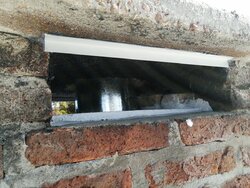
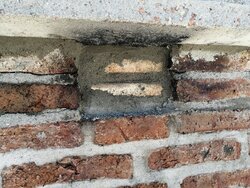
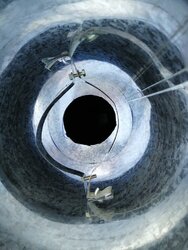
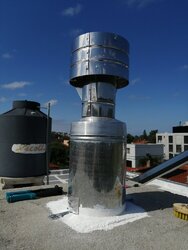
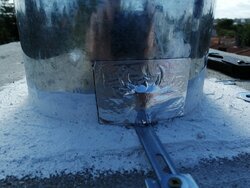
Cemented in the small hole that faces the coast.
Attached the supports and clamp that will hold the upper part of the liner.
Sealed off with the roofing tape we use here. Thick bitumen layered tape.
I'll be adding the roofing tape all around the pipe once all installed





Been watching this and you people are making progress and like everything else that people face it seems to be the little things that interfere with the progress moving forward so the job gets done...(Like for instance those screws and that tape that would burn at certain temperatures)..Now I have a real green question --In the picture where the orange glove is on the table ---that's inside I believe and why do you have that loose looking foil or soft liner with the while foam or something wrapped around that pipe? Curious because I am going to have inside piping to my wood stove and was just wondering "why" ..Enjoyable thread ..Thanks..clancey
The white wool is a ceramic fiber blanket. Same material used to wrap exhaust pipes. Extremely high melting point and very low heat conductivity so ideal for insulating the liner.
Tape around it is just to hold the fibers together while you feed the liner up or down the flue.
Most countries sell the flexible liners with double walls and insulation included but not here. Usually installers don't bother, only on the part outside. You can see my part outside with the wide pipe. This will have a 2 inch gap between the liner so will be filled with rock wall once all installed. The tape on the part outside on the top of the roof will not get hot (only with the sun).
Tape around it is just to hold the fibers together while you feed the liner up or down the flue.
Most countries sell the flexible liners with double walls and insulation included but not here. Usually installers don't bother, only on the part outside. You can see my part outside with the wide pipe. This will have a 2 inch gap between the liner so will be filled with rock wall once all installed. The tape on the part outside on the top of the roof will not get hot (only with the sun).
Get a storm collar fabricated out of stainless by a local metal shop. It's just a truncated cone. That will save some maintenance and drips.
As explained before the fabrication shops have no idea of how to cut custom parts they have never seen before. It's a waste of time trying to explain to them what it is.Get a storm collar fabricated out of stainless by a local metal shop. It's just a truncated cone. That will save some maintenance and drips.
Easier just to use the roofing tape which is designed for our strong sun and will last 10 years plus.
Maybe mock one up with stiff paper and bring it to them as a template? It will look like the letter C.As explained before the fabrication shops have no idea of how to cut custom parts they have never seen before. It's a waste of time trying to explain to them what it is.
Easier just to use the roofing tape which is designed for our strong sun and will last 10 years plus.
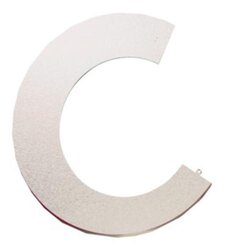
Some really heavy rain today blowing sideways.
Got a few drips coming down. The only place for it to come down is the cover over the inner liner tube inside the cowl at the top.
I will cut up a new wider cover and attach it over the top of this existing cowl. Won't look so pretty but needs to be 100% dry before proceeding
Got a few drips coming down. The only place for it to come down is the cover over the inner liner tube inside the cowl at the top.
I will cut up a new wider cover and attach it over the top of this existing cowl. Won't look so pretty but needs to be 100% dry before proceeding
Attachments
You really can't use aluminum rivets they won't hold up at all and if they are in contact with the galvanized steel it will cause corrosion really quick
Yep absolutely agree. It's what they supply/use here though.
The entire cowl is stainless steel not galvanized though but still they will react I understand even without water contact..
Lack of knowledge/education/training in all of the suppliers/fabricators I guess.
Probably replace them with steel screws
Tried getting steel pop rivets and failed miserably.
The entire cowl is stainless steel not galvanized though but still they will react I understand even without water contact..
Lack of knowledge/education/training in all of the suppliers/fabricators I guess.
Probably replace them with steel screws
Tried getting steel pop rivets and failed miserably.
Last edited:
Similar threads
- Replies
- 8
- Views
- 1K
- Replies
- 11
- Views
- 633
- Replies
- 5
- Views
- 875
- Replies
- 19
- Views
- 4K


